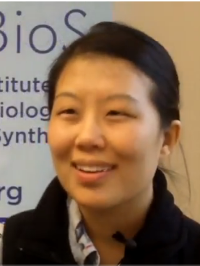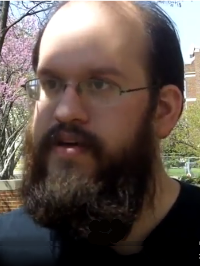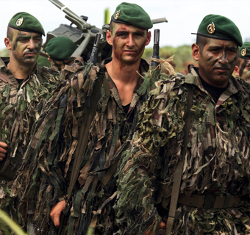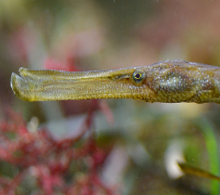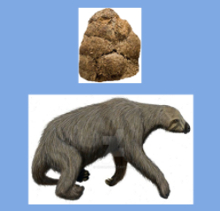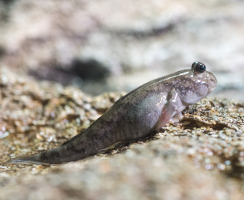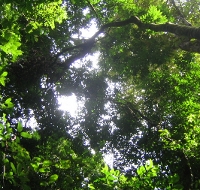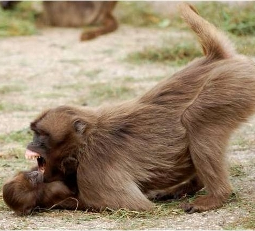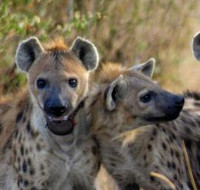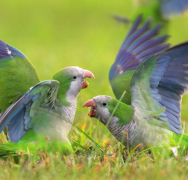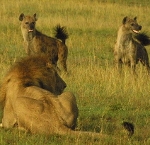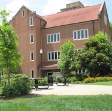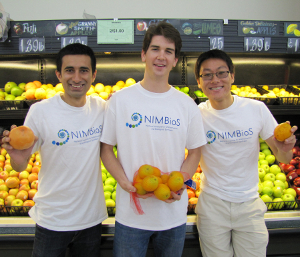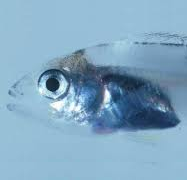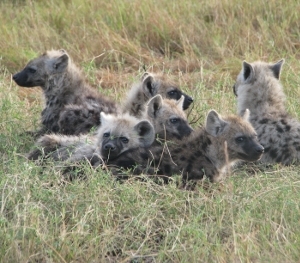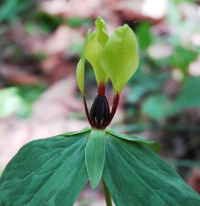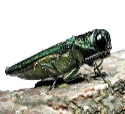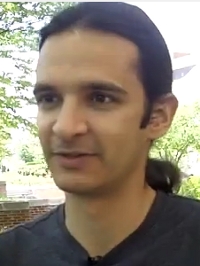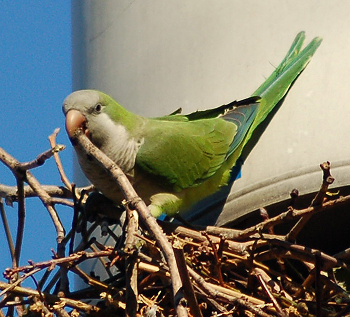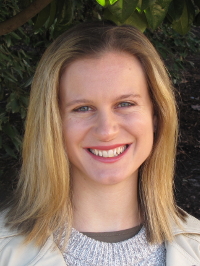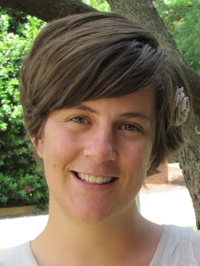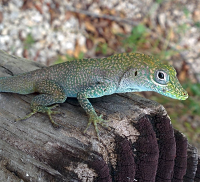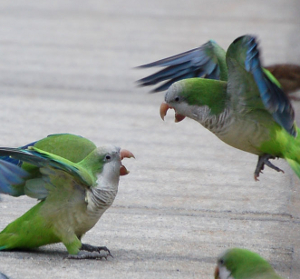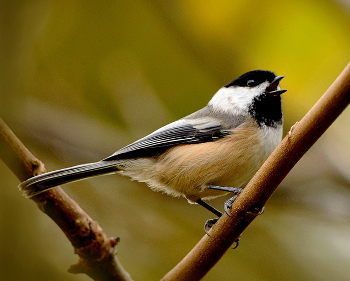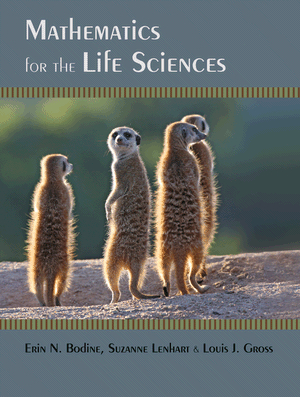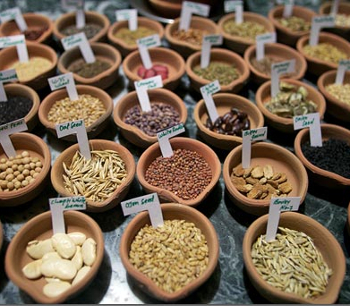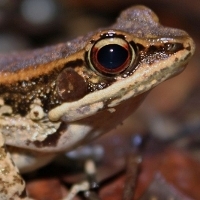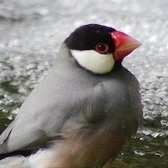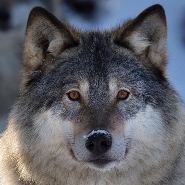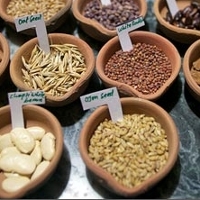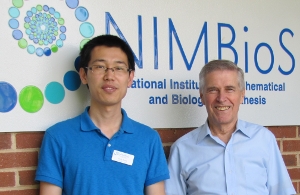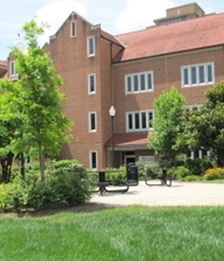Top Stories
October 25, 2020

The Earth has humans, so why don't our climate models?
Climate models lack dynamic representation of human behavior and social systems despite strong feedbacks between social processes and climate.
A recent article published in Climate Change
explores the importance of linking social factors with climate processes and identifies priorities essential to advancing the development of coupled social-climate models.
Citation:
Beckage B, Lacasse K, Winter JM et al. 2020. The Earth has humans, so why don't our climate models? Climatic Change. https://doi.org/10.1007/s10584-020-02897-x [Link]
June 16, 2020
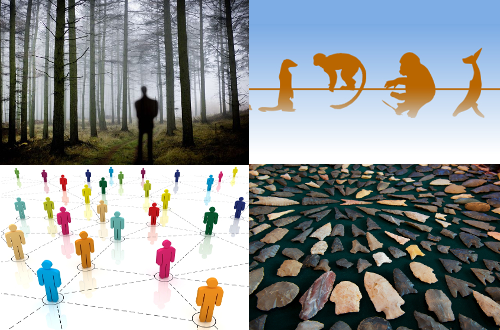
New online tutorials: Dynamical systems in cultural evolution
To truly understand how culture evolves, scientists often turn to mathematical models to shed light on how culture and life history have interacted in shaping who we are and what we might become.
The Center for the Dynamics of Society Complexity (DySoC) and the Cultural Evolution Society (CES) announce a new online learning series presenting basic and applied lessons in the dynamics of cultural evolution.
April 22, 2020
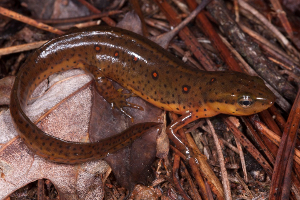
Newt Distancing?
New experimental work and corresponding disease models published in Scientific Reports show that increasing habitat complexity in populations of eastern newts lessens newt-to-newt contact and decreases the basic reproductive rate of the pathogen Batrachochytrium salamandrivorans. But, can lessened contact be enough to save these sensitive salamanders from the disease?
Photo by T. Pierson
Citation:
Malagon, DA et al. 2020. Host density and habitat structure influence host contact rates and Batrachochytrium salamandrivorans transmission. Scientific Reports.
[Link]
March 16, 2020
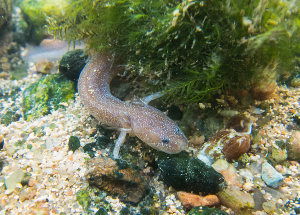
Bargain-Hunting for Biodiversity
The best bargains for conserving some of the world's most vulnerable salamanders and other vertebrate species can be found in Central Texas and the Appalachians, according to new research from NIMBioS published in Ecological Applications.
Citation:
Armsworth PR et al. 2020. Allocating resources for land protection using continuous optimization: biodiversity conservation in the United States. Ecological Applications.
[Link]
February 10, 2020
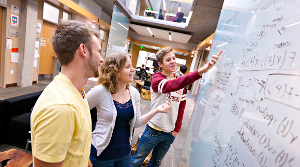
Quantitative Biology in Community College
Over half of community college students are referred to remedial math courses, and yet many community college students pursue careers in health sciences or biotechnology, which necessitates quantitative skills. A new study in CBE–Life Sciences Education from the NIMBioS Working Group on Quant Bio@Community College examines the challenges and opportunities and offers recommendations for teaching quantitative skills in community college biology classes.
Citation:
Corwin LA, Kiser S, LoRe SM, Miller JM, Aikens ML. 2019. Community college instructors' perceptions of constraints and affordances related to teaching quantitative biology skills and concepts. CBE–Life Sciences Education 18:4
[Link]
January 5, 2020
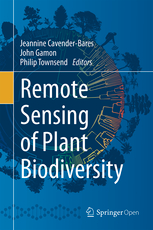
Remote Sensing of Biodiversity
The NIMBioS Working Group on Remotely Sensing Biodiversity has published a book,
Remote Sensing of Plant Biodiversity (Springer, 2020). The Open Access volume aims to methodologically improve our understanding of biodiversity by linking disciplines that incorporate remote sensing and by uniting data and perspectives in the fields of biology, landscape ecology, and geography. The book provides a framework for how biodiversity can be detected and evaluated—focusing particularly on plants—using proximal and remotely sensed hyperspectral data and other tools such as LiDAR.
Citation:
Remote Sensing of Plant Biodiversity. 2020. Cavender-Bares J, Gamon J, Townsend P (Eds.)
Springer International Publishing. eBook ISBN:978-3-030-33157-3. Hardcover ISBN:978-3-030-33156-6. DOI:10.1007/978-3-030-33157-3.
[Link]
November 26, 2019

Pathogens and Mutualists in Plant Competition and Succession
In a paper published in The American Naturalist, the NIMBioS Working Group on Plant-Soil Feedback Theory investigates the implications for plant competition and succession with pathogens and mutualists as joint drivers of host species coexistence and turnover.
The study shows how a combination of positive and negative plant-microbe feedbacks can generate a coexistence state that is part of a set of alternative stable states, suggesting that classical plant-soil feedback experiments may be susceptible to disturbances.
Citation:
Jiang J et al. 2019. Pathogens and mutualists as joint drivers of host species coexistence and turnover: implications for plant competition and succession. The American Naturalist.
[Online]
September 10, 2019

Saving Amphibians, One Tadpole at a Time
Angela Peace and Suzanne O'Regan, along with UT's Matt Gray, has culminated in A collaboration with former NIMBioS postdocs a new study in Ecological Modeling that investigates the dynamics of a highly virulent ranavirus. Targeting only one transmission pathway is unlikely to thwart invasion, the study finds.
Citation:
Peace A et al. 2019. A highly invasive chimeric ranavirus can decimate tadpole populations rapidly through multiple transmission pathways. Ecological Modelling 410:108777. [Online]
Learn more about this story »
April 3, 2019
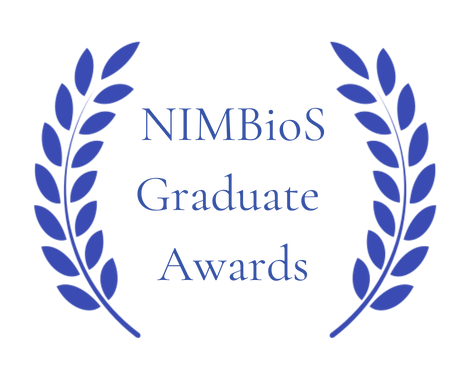
NIMBioS Awards $50,000 to UT Graduate Students
NIMBioS is pleased to announce the 20 graduate students who will each receive a $2500 award to supplement their funding for research and education at the University of Tennessee, Knoxville.
The awards support research and education in areas that align with the efforts of NIMBioS at the interface of the quantitative and life sciences as well as areas connected with the four NIMBioS-affiliated programs, which include the National Institute for STEM Evaluation and Research, the Center for the Dynamics of Social Complexity, the Spatial Analysis Lab, and the Mathematical Modeling Consulting Center.
Learn more about this story »
February 4, 2019

Scientists strategize for better conservation plans
New research published in Trends in Ecology & Evolution estimates species' niche by incorporating evolutionary information above and below the level of species. Initiated by the activities of the NIMBioS Investigative Workshop on Species' Range Shifts in a Warming World, a team of scientists reviewed three strategies for incorporating evolutionary information in niche models. The research challenges traditional practices for modeling evolutionary relationships at the species level.
Learn more about this publication »
November 8, 2018

Templeton Foundation funds project to advance study of cultural evolution
A new effort from the Center for the Dynamics of Society Complexity (DySoC) at the University of Tennessee to bring tools from the natural sciences to the social sciences to better understand cultural evolution has been awarded funding from the John Templeton Foundation.
Learn more about this story »
October 8, 2018

New quantitative skills curriculum wins funding
A unique program developed by the NIMBioS to bring quantitative education to graduate students in the life sciences has been awarded funding from the Burroughs Wellcome Fund (BWF), one of only three BWF awards to be made nationally.
Learn more about this story »
October 4, 2018
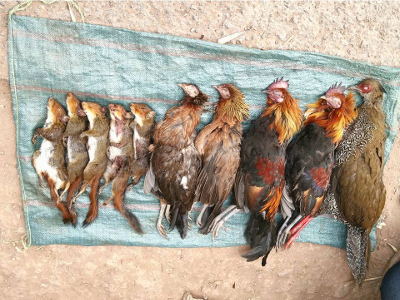
Bag a job, bag a prey: Search theory used to manage threats from overhunting
How many jobs should an applicant consider before accepting the next job offer? Turns out the same decision-making process that goes into searching for a job also applies to hunters searching for prey, and the knowledge can be used in conservation. In a new study, researchers used a job search theoretical model to better understand hunters' decision-making in order to develop conservation tools to address overhunting in the tropics, where more than three-quarters of all plant and animal species live.
Learn more about this publication »
September 13, 2018

Classifying long transient dynamics.
A new paper published in Science by the NIMBioS Working Group on Long Transients and Ecological Forecasting proposes a classification system for ecological dynamics that persist over ecologically relevant time scales—dozens of generations or longer. In this review, the authors turn to dynamical systems theory to develop a classification scheme that categorizes the mechanisms underlying transients. The study also links empirical observations to simple prototypical models. The systematic framework described in the review could be useful for ecosystem management.
Learn more about this publication »
August 1, 2018
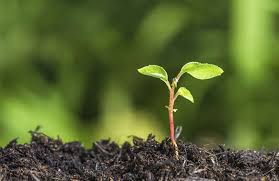
Extending the theory about plant-soil feedback in the social network of trees.
In a new study published in Nature Ecology & Evolution, researchers mathematically describe the social network that creates and maintains forest biodiversity. The paper presents a general equation that characterizes the interactions of any tree-microbe network, whether it consists of two or 2,000 species, by a single number. The work was the result of the activities of a NIMBioS Working Group, including two NIMBioS postdoctoral fellows and a sabbatical visitor.
Learn more about this publication »
May 23, 2018
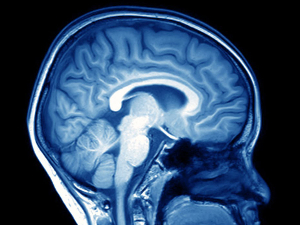
Mathematical modeling simulates evolution to explain humans' large brain.
Why did the human brain evolve to its unusually large size? Former NIMBioS GRA Mauricio Gonzalez Forero has some answers in a new Nature publication that develops a mechanistic model showing brain expansion was likely driven by ecological, not social, processes.
Learn more about this publication »
April 17, 2018
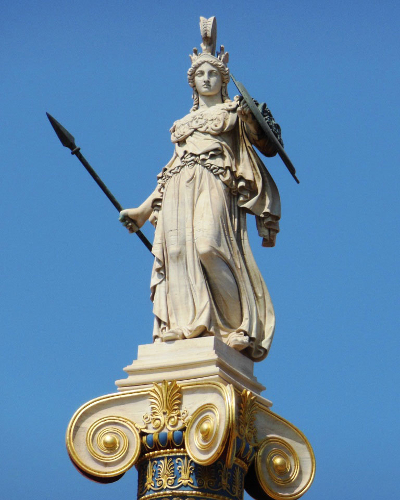
US Defense Department supports new DySoC research on political instability
Sergey Gavrilets, NIMBioS Associate Director for Scientific Activities and director of the Center for the Dynamics of Social Complexity (DySoC), was recently awarded a three-year grant from the US Department of Defense's Minerva Research Initiative.
The project, "Integrating structural theories of revolution with evolutionary models to predict societal resilience and (in)stability," will develop new mathematical modeling tools to investigate political revolutions and the resilience of human societies to shocks.
The results are expected to have wide-ranging applications to a number of different fields, including evolutionary biology, anthropology, psychology, economics, organization research, political science and history.
Read the full story.
April 16, 2018
Hunting in the tropics
Dr. Charlotte Chang is a postdoctoral fellow at the National Institute for Mathematical and Biological Synthesis (NIMBioS).
She is exploring the impact of diverse socio-cultural hunting practices as well as the response of hunting pressure to the spatial and temporal distribution of different harvested goods.
Watch the NIMBioS video interview:
April 16, 2018 (2 min 28 sec)
April 16, 2018
Modeling cell differentiation and its role in cancer
Dr. Nicholas Panchy is a postdoctoral fellow at the National Institute for Mathematical and Biological Synthesis (NIMBioS).
He is exploring the role and regulation of intermediate epithelial-to-mesenchymal transition (EMT) cell-types by modeling gene regulatory networks controlling expression across EMT.
Watch the NIMBioS video interview:
April 16, 2018 (2 min 05 sec)
January 1, 2018

New center explores dynamics of social complexity
A new center has been established at the University of Tennessee, Knoxville, to promote connections and collaborations between researchers focused on human social behavior. At the Center for the Dynamics of Social Complexity (DySoC), the main goal is to combine system thinking, modeling tools, and big data to develop testable predictions and research into a variety of topics related to human social behavior, such as cooperation, conflict, cultural evolution and dynamics, mass behavior and psychology, and human origins.
Read the full story.
January 1, 2018

Curbing climate change: Study finds strong rationale for the human factor
Humans may be the dominant cause of global temperature rise, but they may also be a crucial factor in helping to reduce it, according to a new study that for the first time builds a novel model to measure the effects of changes in human behavior in response to climate change, such as installing solar panels or insulating homes.
Read the full story.
December 19, 2017

|
| ©2011 Andrew v. F. Block |
Climate change may favor large plant eaters over small competitors
In the drive to survive changing climates, larger herbivores may fare slightly better than their smaller competitors, according to new research from NIMBioS and the Yale School of Forestry and Environmental Studies.
Read the full story.
June 29, 2017
Gross named new director of NIMBioS
Louis J. Gross has been named the new director of NIMBioS, effective July 1, 2017.
Gross is a distinguished professor of ecology and evolutionary biology and mathematics at the University of Tennessee, Knoxville, the founding director of NIMBioS and director of the Institute for Environmental Modeling (TIEM). His research focuses on computational and mathematical ecology, with applications to plant ecology, conservation biology, natural resource management, and landscape ecology.
NIMBioS was founded in 2008 as a National Science Foundation (NSF) Synthesis Center supported through NSF's Biological Sciences Directorate via a Cooperative Agreement with UT Knoxville totaling more than $35 million over ten years.
"As NIMBioS Director, I look forward to helping ensure that this NSF Synthesis Center continues as the premier center that fosters fascinating biology research and education at the interface with quantitative methods," Gross said.
Read the full story.
June 20, 2017
Mathematical biology tackles destructive plant virus
Plant diseases pose a serious threat to global food security, especially in developing countries, where millions of people depend on consuming what they harvest. In sub-Saharan Africa, maize lethal necrosis is ravaging one of the region's preferred crops for food, feed and income. But understanding its biology is difficult because the disease arises from the interaction of two viruses. In a study published in the journal Phytopathology, a team of researchers at NIMBioS has used mathematical modeling to better understand the dynamics of the disease and how to manage it.
Read the full story.
May 22, 2017
The right thing to do: Why do we follow unspoken group rules?
Following social norms can sometimes be costly for individuals if norms require sacrifice for the good of the group. How and why did humans evolve to follow social norms? A new study from NIMBioS explores this question, shedding light on the power of norms and the origins of human cooperation. The results, published in the Proceedings of the National Academy of Sciences, show that the ability of humans to internalize social norms is expected to evolve under a wide range of conditions, helping to forge a kind of cooperation that becomes instinctive.
Read the full story.
Mar 20, 2017
New test detects early stage of wasting disease in cattle
Researchers at NIMBioS have identified a more sensitive test for detecting the early stages of paratuberculosis, a fatal disease that plagues dairy herds and causes an estimated annual loss of up to $250 million to the US dairy industry.
The research, published in Nature's Scientific Reports, found that the standard fecal test could not reliably predict persistent infections or early stages
and determined that a test based on a type of immune cells called macrophages produces more reliable diagnoses.
Read the full story.
March 14, 2017
Power of shared pain triggers extreme self-sacrifice
The extreme self-sacrificial behavior found in suicide bombers and soldiers presents an evolutionary puzzle: how can a trait that calls for an individual to make the ultimate sacrifice, especially in defense of a group of non-kin, persist over evolutionary time?
A new study published in Nature's Scientific Reports lends insight into the causes of self-sacrifice in violent conflicts around the world, from holy wars to gangland violence.
Visceral bonding over shared painful experiences can lead to an extreme type of cooperation.
Read the full story.
Jan 4, 2017
Male pipefish pregnancy, it's complicated
In the upside-down world of the pipefish, sexual selection appears to work in reverse, with flashy females battling for males who bear the pregnancy and carry their young to term in their brood pouch. But new research published in the journal Behavioral Ecology and Sociobiology shows a variety of factors play a role in determining mating success.
Read the full story.
Nov 29, 2016
Human groups key to preserving natural resources
Learning between human social groups may be key to sustaining the environment, according to a new study
published in Ecological Economics that uses mathematical modeling to understand what factors most influence societies to conserve natural resources.
Read the full story.
Oct 3, 2016
New national institute explores evaluation science
A new national institute has been established at UT, Knoxville, to provide independent evaluations of research and education programs in the science, technology, engineering and mathematics sectors.
At the National Institute for STEM Evaluation and Research (NISER), the main goals are not only to provide evaluation services to academia, government, and the non-profit sectors but also to generate new knowledge about the ways in which integrated STEM programs function successfully.
Read the full story.
Sep 26, 2016
New fossil computer game teaches science, math fundamentals
Dig for fossils and learn about geologic time with a new computer game – Fossil Finder! – developed by undergraduate students at NIMBioS.
Primarily aimed for students in grades 6-8, Fossil Finder! teaches the fundamentals of scientific notation, exponents as well as the concepts of geological time scales and the increasing complexity of life over time.
The game drew inspiration from the Biology in a Box program, which uses hands-on materials to teach integrated science, technology, engineering and math concepts to students in grades K-12.
The game will become part of the program, which is used in over 90 school systems in Tennessee, Georgia, Kentucky, North Carolina and Washington, DC.
Read the full story.
Jul 7, 2016
Tails might have helped vertebrates evolve from sea to land
When early terrestrial animals began moving about on mud and sand 360 million years ago, the powerful tails they used as fish may have been more important than scientists previously realized. That's one conclusion from a new study published
in the journal Science of African mudskipper fish and a robot modeled on the animal.
Read the full story.
Jun 8, 2016
Mathematical simulation of open-heart surgery lends clues to kidney failure
Nearly a third of all patients undergoing heart surgery experience kidney failure, yet little is known about why kidney injury occurs or how to prevent it.
A new study published in the journal Mathematical Medicine and Biology, reports findings of
a team of researchers in the US and Australia who investigated the causes of kidney injury using a mathematical model that simulates typical open-heart surgery. The model shows that the amount of oxygen within certain sub-regions of the kidney drops to critical levels during surgery, making these sub-regions vulnerable to hypoxia, which could result in injury to the kidneys.
Read the full story.
Jun 3, 2016
Constructing shale gas sites: Algorithm reduces environmental impact at reasonable expense
Extracting gas from shale rock not only causes environmental disturbances below ground, the surface infrastructure required to drill the wells can cause a variety of problems above ground, from fragmenting fragile habitats, eroding soil, degrading freshwater systems and displacing rare species.
Minimizing the environmental consequences above-ground is possible, but at a cost to the developers. However, a new study published in Conservation Biology suggests that the additional cost to developers is far smaller than the savings made to the environment.
Read the full story.
Jan 25, 2016
Study shows large variability in abundance of viruses that infect ocean microorganisms
Viruses infect more than humans or plants. For microorganisms in the oceans - including those that capture half of the carbon taken out of the atmosphere every day - viruses are a major threat. But a paper to be published January 25 in the journal Nature Microbiology shows that there's much less certainty about the size of these viral populations than scientists had long believed. The new study was initiated as part of the NIMBioS Ocean Viral Dynamics Working Group.
Read the full story.
Jan 7, 2016
Study reveals deep ties between diverse tropical rainforests
Understanding the science of rainforests – the "lungs" of the planet –- is critical to maintaining the fragile balance of Earth's ecosystems. A new study from a team of researchers at NIMBioS, Princeton Univ., and the Smithsonian Tropical Research Institute, published in the journal Science, reveals striking new findings about the structure of tropical rainforests and how the trees in them interact with one another, suggesting important recommendations for how scientists study and model tropical rainforests.
Read the full story.
Jan 4, 2016
New methods help advance infectious disease forecasting
An Anopheles stephensi mosquito is a vector of malaria, and mosquito control is an effective way of reducing its incidence. New methods have been developed to detect the onset of critical transitions in infectious disease epidemics, such as malaria. A study from NIMBioS develops new methods to detect the onset of critical transitions in infectious disease epidemics, such as malaria.
Read the full story.
Dec 17, 2015
The evolution of antievolution policies:
Study shows ancestral relationships of modern creationist legislation
In a new study from NIMBioS published in Science, the evolutionary history of antievolution efforts in state legislatures is statistically reconstructed in a phylogenetic tree to reveal the genealogical relationships among lawmaking efforts over the past decade. The study sheds light on the strategies used by creationists to influence the way biology is taught in the classroom.
Read the full story.
Dec 16, 2015
Special collection explores origin and evolution of play
Research on the evolution and function of play at NIMBioS has culminated in a special issue of the journal Adaptive Behavior that examines the evolution and origin of play via mathematical and computational approaches.
In a series of meetings from 2011 to 2013, the NIMBioS Working Group on Play, Evolution and Sociality brought together mathematicians, anthropologists, zoologists, neuroscientists, ecologists, psychologists and other top experts to examine play as a window into cognitive evolution and the rules of sociality.
Read the full story.
Nov 23, 2015
Strolling salamanders provide clues on how animals evolved to move from water to land
A new study in the Journal of Experimenal Biology by a team of scientists from NIMBioS and Clemson University evaluates what mechanisms drive diversity in bone function, providing new insight into the evolution of how tetrapods – the earliest four-legged vertebrate animals – took their first steps on land.
Read the full story.
Nov 11, 2015
Evaluating science: New approaches to assess science education and research efforts
What works in science and what doesn't and how do we know? As the academic community faces greater scrutiny from external funders as to how and why research or education programs work, the need for external evaluation has never been more apparent. A systems-based model of evaluation considers the organization as a whole, assessing the quality and significance of outcomes while also examining the inputs and processes leading to outcomes. NIMBioS is now offering a suite of evaluative services to aid scientific research and education efforts.
Read the full story.
Nov 6, 2015
What makes a leader? Clues from the animal kingdom
As the American media continues to buzz over who is more or less likely to secure the Republican and Democratic nominations for U.S. President, researchers in the journal Trends in Ecology & Evolution review some interesting perspectives on the nature of leadership. The experts from a wide range of disciplines examined patterns of leadership in a set of small-scale mammalian societies, including humans and other social mammals such as elephants and meerkats.
Read the full story.
Sep 10, 2015
Mental math helps monk parakeets find their place in pecking order
A study of aggression in monk parakeets published in the journal PLOS Computational Biology suggests that where they stand in the pecking order is a function of the birds' carefully calibrated perceptions of the rank of their fellow-feathered friends.
The ability to determine rank appears to be an act of cognitive reasoning.
Read the full story.
Sep 8, 2015
Parasitic Disease: Contact rates, Competition matter in transmission
Contact and competition among different animals within a community matters when it comes to the possibility of parasitic disease outbreak, according to new research from NIMBioS and the University of Georgia, Athens.
The study sheds new light on how parasites spread in animal communities comprised of multiple species, from rhinos to giraffes, lions to hyenas, birds to mice, and more.
Read the full story.
Aug 24, 2015
NIMBioS receives NSF grant to assess student learning in mathematics
NIMBioS has been awarded a two-year, $299,990 grant from the National Science Foundation to develop a new tool to assess whether using real-world biology examples in college-level mathematics courses enhances student understanding of quantitative concepts.
"Our hope is that the project will provide a unique way to enhance student learning of mathematical concepts," said NIMBioS Associate Director for STEM Evaluation Pamela Bishop, who will lead the project.
Read the full story.
Aug 5, 2015
Students create tool to stop pests in their tracks
The US Department of Agriculture estimates invasive species to be a $120 billion problem annually.
Invasives often land unintentionally in new areas via cargo ships, boats, airplanes, automobiles and other modes of transportation.
Now there is a new tool to help in the fight against these non-native pests, developed by three college students — Ashish Gauli, Nathan Wikle and Ryan Yan — during their summer research program at NIMBioS.
The tool is ComFlo, an interactive website that can be used to visualize the domestic transport of most common commodities within the United States.
Read the full story.
June 30, 2015
Location isn't everything but timing is for certain spawning fish
The larvae of some species of reef fish appear to survive better depending on the timing of when they were spawned, according to new research from NIMBioS.
The findings, published this month in the journal PLOS ONE, advance earlier research that suggested only spawning location is critical and have important implications for fisheries management and conservation.
Read the full story.
May 15, 2015
It's best to make friends of friends - Even the spotted hyena knows that
Spotted hyenas are affected by the structure of their social network when forming and maintaining social bonds, according to a new study in the journal Ecology Letters of the long-term dynamics of hyena social networks.
Read the full story.
May 12, 2015
The mighty seed
Best conservation practices consider both genetics and biology, says a new study in Biological Conservation.
Including a species' biology in sample guideline calculations for saving seeds, such as the ones that produce some rare trillium species, can dramatically improve sampling effectiveness.
Read the full story.
Apr 29, 2015
Study advances new tool in the fight against invasive species
A new tool could help in controlling biological invasions, such as the emerald ash borer, the Asian beetle which is now advancing on the East Coast after having wiped out up to 80 percent of ash trees in the Midwest.
Read the full story.
Apr 29, 2015
The mathematics of the kidney
Dr. Ioannis Sgouralis is a postdoctoral fellow at the National Institute for Mathematical and Biological Synthesis (NIMBioS). He develops mathematical models to investigate the mechanical mechanisms involved in kidney function.
Watch the NIMBioS video interview:
April 29, 2015 (1 min 50 sec)
Apr 27, 2015
Tracking an invasive bird
The two independent invasions of monk parakeets that have occurred in the United States and in Europe over the last 40-50 years appear to have originated from the same small area in the native range in South America, according to a new study in the journal Molecular Ecology.
Read the full story.
Tipping points in epidemics
Dr. Suzanne O'Regan is a postdoctoral fellow at the National Institute for Mathematical and Biological Synthesis (NIMBioS). She develops mathematical models to identify tipping points in epidemics.
Watch the NIMBioS video interview:
April 23, 2015 (2 min 27 sec)
The math of chemical elements
Dr. Angela Peace is a postdoctoral fellow at the National Institute for Mathematical and Biological Synthesis (NIMBioS). She develops mathematical models in ecology to help understand how important chemical elements affect the world we live in.
Watch the NIMBioS video interview:
(2 min) April 22, 2015
Measuring seasonal effects on animal populations
Dr. Jake Ferguson is a postdoctoral fellow at the National Institute for Mathematical and Biological Synthesis (NIMBioS). He builds models that describe how environmental fluctations translate into the growth or decline of animal populations.
Watch the NIMBioS video interview:
(1 min 45 sec) April 20, 2015
Jan 22, 2015
Study projects unprecedented loss of corals in Great Barrier Reef
The coverage of living corals on Australia's Great Barrier Reef could decline to less than 10 percent if ocean warming continues, according to a new study that explores the short- and long-term consequences of environmental changes to the reef.
Read the full story.
[Online Pre-Print] 12 January 2015.
Dec 30, 2014
NIMBioS names new director
The National Institute for Mathematical and Biological Synthesis (NIMBioS) will have new leadership beginning in January.
Colleen Jonsson, an expert in infectious disease dynamics and molecular virology, has been named the new NIMBioS Director to begin January 2015.
Jonsson will succeed Louis J. Gross, who has served as NIMBioS director since 2008.
Read the full story.
November 26, 2014
Study: Prehistoric conflict hastened brain's capacity for collaboration
How humans evolved high intelligence, required for complex collaborative activities, despite the various costs of having a big brain, has long puzzled evolutionary biologists.
According to a new study from NIMBioS,
warfare not only hastened human technological progress and vast social and political changes, but may have greatly contributed to the evolutionary emergence of humans' high intelligence and ability to work together toward common goals,
Read the full story.
September 30, 2014
Research confirms controversial Darwin theory of "jump dispersal"
Charles Darwin hypothesized that species could cross oceans and other vast distances on vegetation rafts, icebergs, or in the plumage of birds. A new computational method, published in the journal Systematic Biology, tested two competing theories about how species came to live where they do and found strong evidence for Darwin's "jump dispersal" idea, especially for island species.
Read the full story.
September 17, 2014
Being social: Learning from the behavior of birds
Science has learned a great deal about complex social behavior by studying nonhuman mammals and primates, but parrots might have something to teach too. A new study - the first to quantify the social lives of parrots using social network analysis - reveals a sophisticated social structure with layers of relationships and complex interactions. Read the full story.
Citation: Hobson EA, Avery ML, Wright TF. 2014. The socioecology of Monk Parakeets: Insights into parrot social complexity. AUK 131(4):756-775. [Online]August 20, 2014
The ABCs of animal speech: Not so random after all
The calls of many animals, from whales to wolves, might contain more language-like structure than previously thought,
according to a study
that raises new questions about the evolutionary origins of human language.
The study, led by NIMBioS postdoctoral fellow Dr. Arik Kershenbaum, analyzed the vocal sequences of seven species of birds and mammals and found that the vocal sequences produced by the animals appear to be generated by complex statistical processes, more akin to human language.
Read the full story.
August 19, 2014
New textbook introduces undergraduates to mathematics for the life sciences
Mathematics for the Life Sciences, published by Princeton Press and co-authored by scientists at NIMBioS, teaches readers about basic mathematical and statistical methods that can be used to explore and explain biological phenomena.
Suitable for entry-level students in biology, agriculture, forestry, wildlife, veterinary science, pre-medicine or pre-health, the textbook introduces readers to the variety of mathematical methods used to create and evaluate models in biology.
Read the full story.
July 30, 2014
Saving seeds the right way can save the world's plants
Exotic pests, shrinking ranges and a changing climate threaten some of the world's most rare and ecologically important plants, and so conservationists establish seed collections in hopes of preserving genetic diversity. For decades, these seed collections have been guided by a simple one-size-fits-all approach for how many seeds to gather. A new study led by NIMBioS postdoctoral fellow Dr. Sean Hoban, however, has found that more careful tailoring of seed collections to specific species and situations is critical to preserving plant diversity. Read the full story.
Citation: Hoban S, Schlarbaum S. Optimal sampling of seeds from plant populations for ex-situ conservation of genetic biodiversity, considering realistic population structure. Biological Conservation 177: 90-99. DOI: 10.1016/j.biocon.2014.06.014. [Online]July 9, 2014
Potential new culprit in amphibian extinctions
Amphibian declines and extinctions around the world have been linked to an emerging fungal disease called chytridiomycosis, but new research from NIMBioS shows that another pathogen, ranavirus, may also contribute. "Just as the chytrid fungus has decimated frog populations, the results of our study suggest that ranavirus infection too could contribute to extinction of amphibian populations that are demographically isolated," said lead author and NIMBioS postdoctoral fellow Julia Earl. Read the full story.
Citation: Earl JE, Gray MJ. June 2014. Introduction of ranavirus to isolated wood frog populations could cause local extinction. EcoHealth. DOI: 10.1007/s10393-014-0950-y [Online]
Origins of political institutions
Dr. Matt Zefferman
is a postdoctoral fellow at the National Institute for Mathematical and Biological Synthesis (NIMBioS).
He uses analytical and computational models to investigate the origins of complex political and economic institutions.
Watch the NIMBioS video interview: (2 min 48 sec) June 18, 2014
The origin of species
Dr. Nick Matzke
is a postdoctoral fellow at the National Institute for Mathematical and Biological Synthesis (NIMBioS). He seeks to understand the biogeographical history of species and so develops methods that combine historical and ecological biogeography.
Watch the NIMBioS video interview: (3 min 30 sec) June 4, 2014
May 29, 2014
Howling for peace
Sara Waller, associate professor of philosophy at Montana State University Bozeman, is working with collaborators at NIMBioS and the University of Tennessee to develop theoretical and computing tools to help listen and distinguish between vocalizations that occur in groups of cooperative predators. The research could lead to new non-violent tools for farmers trying to keep predators away from livestock or for people wishing to enjoy the natural environment while staying out of danger. Read the full story.
Seed saver (video)
Dr. Sean Hoban
is a postdoctoral fellow at the National Institute for Mathematical and Biological Synthesis (NIMBioS). He is developing simulation-based sampling guidelines for conserving the genetic resources of rare or economically important plant species.
Watch the NIMBioS video interview: (3 min 22 sec) May 29, 2014
Computation for Chagas
Dr. Clemente Aguilar
is a postdoctoral fellow at the National Institute for Mathematical and Biological Synthesis (NIMBioS). He develops mathematical models that can be used for vaccine development for Chagas disease and southern cattle fever.
Watch the NIMBioS video interview: (2 min 52 sec) May 5, 2014
How will climate change affect the spread of disease?
At NIMBioS, a group of disease experts, climate modelers and mathematicians have come together to improve the forecasting and prediction of climate-induced disease. Will the entire planet be engulfed in a malarial zone, as some models say, or will there be no net increase of malaria? Find out more in this interview with disease ecologist Dr. Richard Ostfeld.
(NIMBioS video: 6 min 16 sec) Dec 6, 2013
May 2, 2014
Researchers receive top honors for ecology paper
NIMBioS postdoctoral fellow Jiang Jiang (left) and University of Miami ecologist Don DeAngelis (right) have won the 2014 best paper award from the Ecological Society of America for their theoretical paper on the ecological linkages between organisms and their environment. Read the full story.
Citation: Jiang J, DeAngelis DL. 2013. Strong species-environment feedback shapes plant community assembly along environmental gradients. Ecology and Evolution. DOI: 10.1002/ece3.784 [Online]Mar 26, 2014
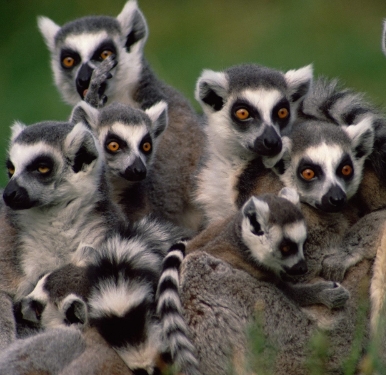
The altruistic side of aggressive greed
In many group-living species, high-rank individuals bully their group-mates to get what they want, but their contribution is key to success in conflict with other groups, according to a study that sheds new light on the evolutionary roots of cooperation and group conflict. In a series of mathematical models, researchers from the National Institute for Mathematical and Biological Synthesis and the University of Oxford uncovered a mechanism for explaining how between-group conflict influences within-group cooperation and how genes for this behavior might be maintained in the population by natural selection. Read the full story.
Citation: Gavrilets S, Fortunato L. 2014. A solution to the collective action problem in between-group conflict with within-group inequality. Nature Communications. [Open access online]Oct 23, 2013
NIMBioS wins $18 million renewal award from National Science Foundation
The National Science Foundation (NSF) has awarded $18.6 million to the University of Tennessee, Knoxville, for the National Institute for Mathematical and Biological Synthesis (NIMBioS) to continue its interdisciplinary efforts in developing new mathematical approaches to problems across biology, from the level of the genome to individuals to entire ecosystems.
Click here to read more.
Oct 23, 2013
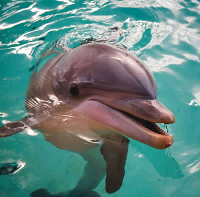
Name that tune
The same algorithm used to find tunes in music retrieval systems has been successfully applied in identifying the signature whistles of dolphins, affording a new time-saving device for research into the world of dolphin communication. A study, published Oct. 23 in the journal PLOS ONE, describes a new method. Read the full story.
Citation: Kershenbaum A, Sayigh LS, Janik VM. 2013. The encoding of individual identity in dolphin signature whistles: how much information is needed? PLOS ONE. [Online]Oct 9, 2013

Climate change threatens Northern American turtle habitat
Although a turtle's home may be on its back, some North American turtles face an uncertain future as a warming climate threatens to reduce their suitable habitat. A new study that reconstructs the effects of past climatic changes on 59 species of North American turtles finds that the centers of the turtles’ ranges shifted an average of 45 miles for each degree of warming or cooling. While some species were able to find widespread suitable climate, other species, many of which today are endangered, were left with only minimal habitat. Read the full story.
Citation: Rödder D, Lawing AM, Flecks M, Ahmadzadeh F, Dambach J, Engler JO, Habel JC, Hartmann T, Hörnes D, Ihlow F, Schiedelko K, Stiels D, Polly DP. 2013. Evaluating the significance of paleophylogeographic species distribution models in reconstructing quaternary range-shifts of Nearctic Chelonians. PLOS ONE. [Online]Sep 23, 2013
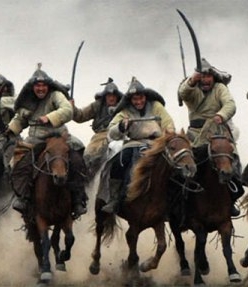
Mathematical model explains how complex societies emerge, collapse
The instability of large, complex societies is a predictable phenomenon, according to a new mathematical model that explores the emergence of early human societies via warfare. Capturing hundreds of years of human history, the model reveals the dynamical nature of societies, which can be difficult to uncover in archaeological data. Read the full story.
Citation: Turchin P, Currie T, Turner E, Gavrilets S. 2013. War, space, and the evolution of Old World complex societies. PNAS. [Online]Aug 27, 2013
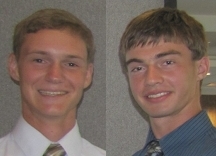
NIMBioS helps high school seniors with award-winning science
KNOXVILLE—Two Tennessee high school students have now done what many scientists strive for: publishing their research in a top science journal. Dalton Chaffee and Hayes Griffin began their study on mate choice, which appears this week in the journal Evolution, between their junior and senior years at Bearden High School in Knoxville, TN. The students wanted to know why individuals choose the mates they choose and worked with their mentor R. Tucker Gilman, then a postdoctoral research fellow at the National Institute for Mathematical and Biological Synthesis at the University of Tennessee, to find out. Read the full story.
Citation: Chaffee DW, Hayes G, Gilman RT. 2013. Sexual imprinting: What strategies should we expect to see in nature? Evolution. [Online]Aug 19, 2013

|
| Credit: Peter Yanoviak |
Altruism or manipulated helping?
Manipulation is often thought of as morally repugnant, but it might be particularly likely to cause the evolution of helpful or altruistic behavior, according to a new study. In a study published online in the journal American Naturalist, the researchers developed a mathematical model showing that resistance to manipulation may often fail to evolve, making helping particularly likely to arise from manipulation itself. Read the full story.
Citation: González-Forero M, Gavrilets S. 2013. Evolution of manipulated behavior. The American Naturalist.Article is in press: DOI: 10.1086/671932
Aug 5, 2013

|
| Credit: Orou Gaoue |
Chronic harvesting threatens tropical tree
Chronic harvesting of a tropical tree that many local communities in Western Africa depend on can alter the tree's reproduction and drastically curtail fruit and seed yields over the tree's lifetime, according to a new study in the Journal of Ecology.
Read the full story.
Jul 17, 2013

Coping with the cold: Study offers clues to how plants evolved in icy climates
Researchers have found new clues to how plants evolved to withstand wintry weather. In a study, which appeared December 22 in the journal Nature, researchers constructed an evolutionary tree of more than 32,000 species of flowering plants — the largest time-scaled evolutionary tree to date. Combining their evolutionary tree with freezing exposure records and leaf and stem data for thousands of species, the researchers were able to reconstruct how plants evolved to cope with cold as they spread across the globe. (Photo credit: S. Uribe-Convers) Read the full story.
Citation: Zanne, A., et al. 2013. Three keys to the radiation of angiosperms into freezing environments. Nature. [Online]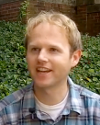
Animals, nutrients and toxins
Dr. Chris Remien is a postdoctoral fellow at the National Institute for Mathematical and Biological Synthesis (NIMBioS). Dr. Remien develops dynamic mathematical models to understand the role of diet and metabolism on stable isotope ratios of animal tissues.
(NIMBioS video: 2 min 00 sec) Jun 21, 2013

Selection in the wild
Dr. Ryan Martin is a postdoctoral fellow at the National Institute for Mathematical and Biological Synthesis (NIMBioS). As an evolutionary ecologist, Dr. Martin studies how aspects of the environment can cause evolution through natural selection in wild populations.
(NIMBioS video: 2 min 24 sec) Jun 20, 2013
Jun 19, 2013
|
|
| Credit: Mathieu Joron |
Biological fitness trumps other traits in mating game
When a new species emerges following adaptive changes to its local environment, the process of choosing a mate can help protect the new species' genetic identity and increase the likelihood of its survival. But of the many observable traits in a potential mate, which particular traits does a female tend to prefer? A new study from the National Institute for Mathematical and Biological Synthesis finds that a female's mating decisions are largely based on traits that reflect fitness or those that help males perform well under the local ecological conditions. Read the full story.
Citation: Thibert-Plante X, Gavrilets S. 2013. Evolution of mate choice and the so called magic traits in ecological speciation. Ecology Letters. DOI: 10.1111/ele.12131 [Online]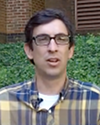
New models in the tree of life
Dr. Jeremy Beaulieu is a postdoctoral fellow at the National Institute for Mathematical and Biological Synthesis (NIMBioS). Dr. Beaulieu is developing a new set of ancestral state reconstruction methods that make more realistic assumptions about how characters evolve across very large phylogenies.
(NIMBioS video: 1 min 43 sec) Jun 19, 2013
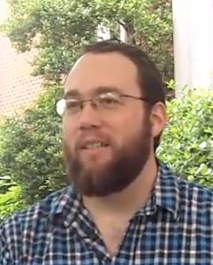
The evolution of cooperation
Dr. Keenan Mack is a postdoctoral fellow at the National Institute for Mathematical and Biological Synthesis (NIMBioS). Dr. Mack studies the costs and benefits involved in the evolution of cooperation.
(NIMBioS video: 2 min 19 sec) Jun 18, 2013
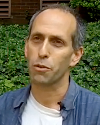
Talking to the animals
Dr. Arik Kershenbaum is a postdoctoral fellow at the National Institute for Mathematical and Biological Synthesis (NIMBioS). Dr. Kershenbaum studies the mathematical structure of animal vocal communication and how it evolved into human language.
(NIMBioS video: 2 min 07 sec) Jun 17, 2013

Climate change and coastal vegetation
Dr. Jiang Jiang is a postdoctoral fellow at the National Institute for Mathematical and Biological Synthesis (NIMBioS). Dr. Jiang develops models to help predict and detect the consequences of storm surges on coastal vegetation.
(NIMBioS video: 2 min 05 sec) Jun 13, 2013

Movement ecology
Dr. Julia Earl is a postdoctoral fellow at the National Institute for Mathematical and Biological Synthesis (NIMBioS). Dr. Earl studies the resources that animals, particularly pond-breeding amphibians, move from one ecosystem to another.
(NIMBioS video: 3 min 05 sec) Jun 12, 2013

Animal networks
Dr. Amiyaal Ilany is a postdoctoral fellow at the National Institute for Mathematical and Biological Synthesis (NIMBioS). Dr. Ilany studies the spotted hyena in order to understand the causes and consequences of social network dynamics.
(NIMBioS video: 2 min 50 sec) Jun 11, 2013
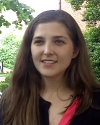
Species and climate change
Dr. Michelle Lawing
is a postdoctoral fellow at the National Institute for Mathematical and Biological Synthesis (NIMBioS). Dr. Lawing uses methods from the biological and geological sciences to study how species respond to climate change.
(NIMBioS video: 1 min 32 sec) May 31, 2013
Apr 22, 2013

|
| Matan Bogomolsky |
Can the friend of my friend be my enemy?
Just as humans can follow complex social situations in deciding whom to befriend or to abandon, it turns out that animals use the same level of sophistication in judging social configurations, according to a new study that advances our understanding of the structure of animal social networks. Read the full story.
Citation: Ilany A, Barocas A, Koren L, Kam M, Geffen E. 2013. Structural balance in the social networks of a wild mammal. Animal Behaviour. Published [online] 22 April 2013.Mar 8, 2013

Net advantage: Study finds use of bed nets could eradicate malaria
Malaria, the leading cause of death among children in Africa, could be eliminated if three-fourths of the population used insecticide-treated bed nets, according to a new NIMBioS study.
Read the full story.
Feb 11, 2013

U.S. Supreme Court under the microscope
Although the current Supreme Court has been criticized for its lack of diversity on the bench, the Court is actually more diverse overall today than ever in history, according to a new study that borrows statistical methods from ecology to reveal a more precise picture of diversity. Read the full story.
Citation: Barton BH, Moran E. 2013. Measuring diversity on the Supreme Court with biodiversity statistics. Journal of Empirical Legal Studies. Published online 18 January 2013.Feb 4, 2013

Avoiding a cartography catastrophe
Since the mid-nineteenth century, maps have helped elucidate the deadly mysteries of diseases like cholera and yellow fever. Yet today’s global mapping of infectious diseases is considerably unreliable and may do little to inform the control of potential outbreaks, according to a new systematic mapping review of all clinically important infectious diseases known to humans. Read the full story.
Citation: Hay SI et al. 2012. Global mapping of infectious disease. Philosophical Transactions of the Royal Society B. Published [online] 4 February 2013.Dec 11, 2012

Epigenetics and the riddle of homosexuality
Epigenetics – how gene expression is regulated by temporary switches, called epi-marks – appears to be a critical and overlooked factor contributing to the long-standing puzzle of why homosexuality occurs. According to the study, published online today in The Quarterly Review of Biology, sex-specific epi-marks, which normally do not pass between generations and are thus "erased," can lead to homosexuality when they escape erasure and are transmitted from father to daughter or mother to son.
Read the full story.
Nov 1, 2012
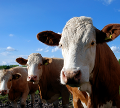
Managing epidemics in information blackouts
When foot-and-mouth disease swept through the British countryside
in early 2001, more than 10 million sheep, cattle and pigs were
slaughtered to control the disease. Despite the devastation, the disease
was contained within ten months in part owing to the availability in
that country of finely detailed farm data, which enabled mathematical
modelers to make accurate predictions about the spread of the disease
and suggest optimal ways of managing it. Should foot-and-mouth disease
occur in the United States today where privacy laws restrict the
accessibility of data, making predictions about the disease might not be
so easy, according to a new study that weighs the costs of privacy in
preventing disease outbreaks.
Read the full story.
Aug 13, 2012

Bullies squelched when bystanders intervene
With new national anti-bullying ads urging parents to teach their kids to speak up if they witness bullying, one researcher has found that in humans' evolutionary past at least, helping the victim of a bully hastened our species' movement toward a more egalitarian society. The drive to help the weaker group members led to a dramatic reduction in group inequality and eventually enabled humans to develop widespread cooperation, empathy, compassion and egalitarian moral values, according to the paper which appears today in the Proceedings of the National Academy of Sciences.
Read the full story.
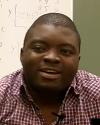
Wild plant harvesting
Dr. Orou Gaoue
is a postdoctoral fellow at NIMBioS. He seeks to understand the global sustainability of harvesting wild plants.
(NIMBioS video: 2 min 40 sec) Aug 15, 2012

The dynamics of small populations
Dr. Andrew Kanarek
is a postdoctoral fellow at NIMBioS. He investigates how individual trait variation influences the dynamics and persistence of small populations.
(NIMBioS video: 1 min 51 sec) Jul 3, 2012

Measures of movement
Dr. Daniel Ryan
is a postdoctoral fellow at NIMBioS. Dr. Ryan
uses mathematical models to investigate how movement affects the way species are distributed in time and space.
(NIMBioS video: 4 min 48 sec) Jun 28, 2012
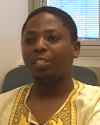
Helping the dairy cow
Dr. Gesham Magombedze
is a postdoctoral fellow at NIMBioS. Dr. Magombedze
is modeling solutions to treat and control the spread of Johne's disease in cattle.
(NIMBioS video: 2 min 40 sec) Jun 25, 2012

Parsimony in phylogenetics
Dr. Juanjuan "JJ" Chai
is a postdoctoral fellow at NIMBioS. Dr. Chai
is helping to solve problems related to research methods used in phylogenetics.
(NIMBioS video: 4 min 23 sec) Jun 22, 2012
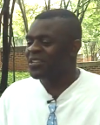
The dynamics of malaria
Dr. Calistus Ngonghala
is a postdoctoral fellow at NIMBioS. Dr. Ngonghala is developing a mathematical model to study the role of mosquito demography in the dynamics of malaria transmission. He also studies the interplay between poverty and disease.
(NIMBioS video: 2 min 46 sec) Jun 19, 2012
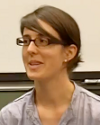
Parasite ecology
Dr. Maud Lélu is a postdoctoral fellow at NIMBioS. She investigates the interactions between parasites, their hosts and the environment and more specifically focuses on the genetic diversity and virulence of Toxoplasma gondii.
(NIMBioS video: 2 min 09 sec) Jun 19, 2012
June 2012

Understanding paratuberculosis
Johne's disease (JD) is a chronic intestinal infection affecting ruminants, and according to the U.S. dairy industry, causes an estimated annual loss of $200 million. In infected cattle, the prolonged and slow infection causes rapid weight loss and diarrhea, which in turn causes decreased milk production and premature culling of clinically infected animals.
May 28, 2012

Family values
In early human evolution, when faithful females began to choose good providers as mates, pair-bonding replaced promiscuity, laying the foundation for the emergence of the institution of the modern family, a new study finds.
May 2012

Non-timber treasures of the forest
Forests are home to a wide variety of plants that provide an array of services to humans. Non-timber forest products are traded as valuable commodities on the international market in the form of edible products, floral greenery, and herbal medicines, among many other products. But the over-harvesting of these wild plants has great ecological consequences.
Apr 2012

The dynamics of small populations
When individuals rely on the presence of others to increase their chances of survival and reproduction, the emergence of adaptations that reduce this dependence can help rescue small populations from extinction. Exploring the ecological and evolutionary consequences of the relationship between individual fitness and population size is the focus of Andrew Kanarek's research as a postdoctoral fellow at NIMBioS.
Apr 2012
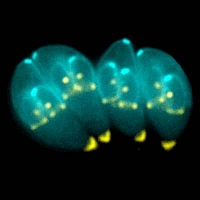
Investigating the pathways of a parasite
Dr. Maud Lélu. It was where her mother became infected with the parasite Toxoplasma gondii while pregnant with Lélu, and where, 27 years later, Lélu successfully defended her doctoral dissertation on the transmission dynamics of the parasite. It was pure coincidence, Lélu said, that she came to study T. gondii, which chronically infects an estimated one-third of the total global population, including Lélu's mother, and Lélu herself, who tested positive for the parasite as an adult.
Mar 2012

Measures of movement
Does the way an organism moves through an ecological community affect its survivability? The question is one that NIMBioS postdoctoral fellow
Daniel Ryan is trying to answer as a part of his research in the field of movement ecology, a discipline that considers all aspects of movement behavior in organisms. From sea turtles to salmon who return home after swimming thousands of miles away, from roaming elephants, migrating birds, spreading bacteria and dispersing seeds, the research attempts to answer why, how, where and when organisms move.
Mar 2012
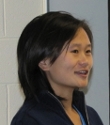
Explorations through time
NIMBioS postdoctoral fellow Juanjuan "J.J." Chai is conducting research in phylogenetics, which studies evolutionary relatedness among groups of organisms through molecular sequencing data and morphological data. Biologists estimate that there are about 5 to 100 million species of organisms living on Earth today, and their genealogical relationships can be represented by evolutionary trees. Chai is working to solve problems related to the methods used in phylogenetics.

NIMBioS interview with Dr. David Schimel
In an interview at NIMBioS, Dr. David Schimel,
chief science officer and principal investigator at the National Ecological Observatory Network (NEON), explains why math is essential in environmental biology and why it matters to the work of NEON.
(NIMBioS video: 8 min 18 sec) Mar 12, 2012

NIMBioS interview with Dr. Lev Ginzburg
In a video interview at NIMBioS,
Dr. Lev Ginzburg, a professor of ecology and evolution at Stony Brook University, explains how his company, Applied Biomathematics, got its start 30 years ago. Dr. Ginzburg visited NIMBioS in February 2012.
(NIMBioS video: 2 min 56 sec) Mar 8, 2012
Mar 4, 2012

Escaping parasites and pathogens
In nature, how do host species survive parasite attacks? This has not been well understood, until now. A new mathematical model shows that when a host and its parasite each have multiple traits governing their interaction, the host has a unique evolutionary advantage that helps it survive. The results are important because they might help explain how humans as well as plants and animals evolve to withstand parasite onslaught. Two postdoctoral fellows at NIMBioS are among the authors of the research, which was published in the March 4 online edition of Nature.
Feb 10, 2012

The noes have it
NIMBioS hosted a lively debate on the role of warfare in early social evolution.
The debate, held Feb. 8, 2012, in the University of Tennessee's (UT) University Center, was designed to raise questions about how science can explain the transition from simple to complex societies.
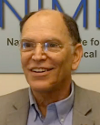
NIMBioS interview with Dr. Jeremy Sabloff
Dr. Jeremy Sabloff, president of the Santa Fe Institute (SFI), explains how SFI researchers have used biological laws to understand the nature of cities. Dr. Sabloff, an anthropologist, is a participant in the NIMBioS Investigative Workshop on Modeling Social Complexity.
(NIMBioS video: 4 min 27 sec) Feb 8, 2012

Summer research for undergrads
For eight weeks each summer, undergraduates in math, biology and related fields work on teams to conduct original research at the National Institute for Mathematical and Biological Synthesis (NIMBioS), located at the University of Tennessee, Knoxville. For more information, visit our website at //education/reu.
(NIMBioS video: 6 min 08 sec) Feb 2, 2012
Jan 27, 2012

Solving the malaria problem mathematically
Growing up in Cameroon, Africa, Dr. Calistus Ngonghala witnessed firsthand the devastation poverty and diseases like malaria and HIV/AIDS can bring to a community. His personal experiences have inspired his research in developing mathematical models to help fight malaria and other pandemics and in investigating how health interventions can alleviate vicious cycles of poverty and disease.
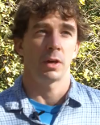
Math for frogs: NIMBioS interview with Dr. Tucker Gilman
Video interview with
Dr. Tucker Gilman, a NIMBioS postdoctoral fellow whose research may may help us predict how ecosystems will respond to man-made disturbances.
(NIMBioS video: 2 min 38 sec) Dec 15, 2011

New Tools for phylogenetics: NIMBioS interview with Dr. Tony Jhwueng
Video interview with
Dr. Tony Jhwueng,
a postdoctoral fellow at NIMBioS who designs new phylogenetic methods for comparative analysis under non-tree-like evolution.
(NIMBioS video: 2 min 29 sec) Dec 5, 2011
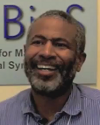
NIMBioS interview with Dr. Scott Edwards
In an interview at the National Institute for Mathematical and Biological Synthesis,
Dr. Scott Edwards,
professor of organismic and evolutionary biology at Harvard University, explains why mathematical biology has become a workhorse in science.
(NIMBioS video: 4 min 16 sec) Dec 1, 2011

NIMBioS interview with Dr. Julia Arciero
In an interview at the National Institute for Mathematical and Biological Synthesis,
Dr. Julia Arciero,
an assistant professor of mathematics at Indiana University-Purdue University Indianapolis, explains how mathematical biology has applications to all other areas of science.
(NIMBioS video: 5 min 35 sec) Nov 11, 2011

NIMBioS interview with Dr. Diana Thomas
In an interview at the National Institute for Mathematical and Biological Synthesis,
Dr. Diana Thomas,
an associate professor of mathematics at Montclair State University, explains how mathematical models can be used to help curb the obesity epidemic.
(NIMBioS video: 2 min 39 sec) Nov 10, 2011

NIMBioS interview with Dr. Anita Layton
In an interview at the National Institute for Mathematical and Biological Synthesis,
Dr. Anita Layton,
an assistant professor of mathematics at Duke University, explains how mathematics is useful in understanding how the kidney works.
(NIMBioS video: 7 min 4 sec) Nov 9, 2011
Nov 4, 2011

Biodiversity can promote survival on a warming planet
Whether a species can evolve to survive climate change may depend on the biodiversity of its ecological community, according to a new mathematical model that simulates the effect of climate change on plants and pollinators.
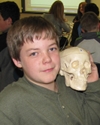
Biology in a Box
Biology in a Box is a fun, hands-on way for students from kindergarten to 12th grade to learn about the wonders of the natural world, while also learning the scientific methods and math skills needed to understand that world. For more information about how to enroll in the program for your school, visit //biologyinabox
(NIMBioS video: 4 min 16 sec) Sep 14, 2011

NIMBioS interview with Dr. Vivek Kapur
In an interview at the National Institute for Mathematical and Biological Synthesis (NIMBioS), Dr. Vivek Kapur,
professor and head of veterinary and biomedical sciences at Penn State University, describes how mathematics can help clarify the chaotic science of biology. Dr. Kapur was a participant in the NIMBioS Investigative Workshop on Modeling Johne's Disease held July 6-8, 2011, at NIMBioS.
(NIMBioS video: 6 min 18 sec) Jul 13, 2011

NIMBioS interview with Dr. Tom Ingersoll
Dr. Tom Ingersoll is a postdoctoral fellow at the National Institute for Mathematical and Biological Synthesis (NIMBioS). He is developing dispersal and dynamic models for the spread of white nose syndrome in bats.
(NIMBioS video: 4 min 30 sec) Jul 12, 2011
Jul 12, 2011

Saving the sublime little bat
NIMBioS postdoctoral fellow Tom Ingersoll is collaborating with fellow bat enthusiasts to understand the cause of and predict the spread of White-Nose Syndrome (WNS) in bat populations. Since first discovered in a cave in upstate New York in 2006, WNS has killed an estimated one million bats in caves and mines in North America. New research predicts regional extinctions of the most common bat species, the little brown bat, within two decades due to WNS. In an interview with NIMBioS, Ingersoll explains his research and how he became interested in the mighty bat.
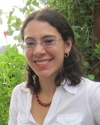
Changing Forests: NIMBioS interview with Dr. Emily Moran
Dr. Emily Moran is a postdoctoral fellow at the National Institute for Mathematical and Biological Synthesis (NIMBioS). She investigates the impact of increasing CO2 on inter-genotype competition and plant-insect interactions in aspen forests in order to develop a modeling framework that could be applied to other forest communities.
(NIMBioS video: 2 min 56 sec) Jul 11, 2011
Jul 8, 2011

Drug designer
Protease inhibitor drugs are one of the major weapons in the fight against HIV, the virus that causes AIDS, but their effectiveness is limited as the virus mutates and develops resistance to the drugs over time. Now a new tool has been developed to help predict the location of the mutations that lead to drug resistance.

The mathematics of malaria: NIMBioS interview with Dr. Olumide Ogundahunsi
Dr. Olumide Ogundahunsi is with the Special Program for Research and Training in Tropical Diseases at the World Health Organization. In an interview at the National Institute for Mathematical and Biological Synthesis (NIMBioS), Dr. Ogundahunsi explains how mathematical modeling can help in the fight against malaria, a disease that claimed nearly one million lives in 2008. Dr. Ogundahunsi was a participant in the NIMBioS Investigative Workshop on Malaria Modeling and Control held June 15-17, 2011, at NIMBioS. The views expressed by Dr. Ogundahunsi are not necessarily representative of the views of the WHO. (NIMBioS video: 4 min 22 sec) Jun 30, 2011
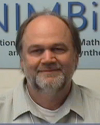
NIMBioS interview with Dr. Volker Grimm
In an interview at the National Institute for Mathematical and Biological Synthesis (NIMBioS), Dr. Volker Grimm of the Helmholz Center for Environmental Research in Germany explains why math is absolutely critical to solving today's pressing ecological problems.
(NIMBioS video: 3 min 07 sec) Jun 29, 2011
Jun 24, 2011

The mechanics of speciation
Mate choice, competition, and the variety of resources available are the key factors influencing how a species evolves into separate species, according to a new mathematical model that integrates all three factors to reveal the dynamics at play in a process called sympatric speciation.
Jun 2, 2011

The legume-rhizobium symbiosis
The symbiosis between legume plants and the bacteria that inhabit their roots seems sweet. These bacteria — called rhizobia — turn nitrogen molecules from the air into a form that the plant can use and, in return, feast on carbohydrates the plant provides. But conflicting interests lurk beneath the surface and can undermine such cooperation, as both parties might prefer to benefit without paying their dues. A new study shows that the process determining the exchange rate of nitrogen and carbohydrates has profound effects on how cooperation can be maintained between legumes and rhizobia.
May 20, 2011
Species reemergence after collapse: Possible but different
Species pairs that disappear through hybridization after human-induced changes to the environment can reemerge if the disturbance is removed, according to a new mathematical model that shows the conditions under which reemergence might happen. The findings, published in the journal Evolution, are important for conservationists and ecosystem managers interested in preserving, or even restoring, systems that have been disturbed by human activity.
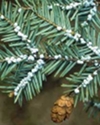
The blight of the hemlock
NIMBioS Songwriter-in-Residence Jay Clark debuts his song, The Day the Last Hemlock Died, which tells the story of the blight of the Eastern Hemlocks in Southern Appalachia. The song ends with a short refrain, a note of optimism, from Aaron Copland's "Appalachian Spring."
For more information about the songwriter-in-residence program, visit //songwriter.
For more information about how to help save the hemlocks, visit
http://www.savinghemlocks.org/.
(NIMBioS video: 6 min 17 sec) May 12, 2011

Inspired by science
In an interview with NIMBioS, singer-songwriter Timothy Sellers explains how science inspires his music. Sellers is lead singer in the Los Angeles-based indie pop band Artichoke. The band has released nine CDs, including a two-volume set of scientist biography songs (NIMBioS video: 2 min 9 sec). Apr 27, 2011
May 3, 2011

Developing new tools for comparative analysis
How does brain mass vary with body mass in a group of species? How does social behavior in insects vary with the number of chromosomes?
These are the sorts of questions biologists might ask when studying a species. One method of exploring these questions is to build comparative models to analyze data in evolutionary relationships. NIMBioS postdoctoral researcher Dwueng-Chwuan "Tony" Jhwueng designs new phylogenetic comparative methods for comparative analysis under non-tree-like or network evolution.
Mar 29, 2011
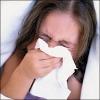
To meet, greet or retreat during influenza outbreaks?
Influenza pandemics can mean that schools close and travellers stay home. But is severing social and business interactions really better than taking a chance on getting sick?
"Infectious disease can mean making trade-offs between the risks and rewards of meeting others,"
says Eli Fenichel, Arizona State University assistant professor and co-organizer of a transdisciplinary working group at NIMBioS that has developed a better model for understanding the role human decisons play in the spread of disease.
A study describing the group's work appears in the journal Proceedings of the National Academy of Sciences (PNAS).
Feb 26, 2011
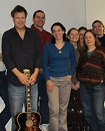
Science for the People, RB Morris
NIMBioS Songwriter-in-Residence RB Morris performs his song Science for the People.
Click here to view the video. (NIMBioS video: 6 min 34 sec) Feb 26, 2011
Feb 14, 2011

Culling won't stop white-nose in bats
Culling will not stop the spread of a deadly fungus that is threatening to wipe out hibernating bats in North America, according to a new mathematical model. The new model examines how white-nose syndrome is passed from bat to bat and concludes that culling would not work because of the complexity of bat life history and because the fungal pathogen occurs in the caves and mines where the bats live.
Feb 9, 2011

Seeking answers in the forest
NIMBioS postdoctoral fellow Emily Moran is interested in learning about how plants respond to changes in their environment. Moran investigates the impact of increasing CO2 on inter-genotype competition and plant-insect interactions in aspen forests in order to develop a modeling framework that could be applied to other forest communities. In an interview with NIMBioS, Moran explains her research and how she became interested in science and the field of ecology.
Jan 19, 2011

Mathematical model explains how complex societies emerge, collapse
The instability of large, complex societies is a predictable phenomenon, according to a new mathematical model that explores the emergence of early human societies via warfare. Capturing hundreds of years of human history, the model reveals the dynamical nature of societies, which can be difficult to uncover in archaeological data.
Dec 8, 2010

Turning swords into plowshares
When two individuals face off in conflict, the classic problem in evolutionary biology known as the prisoner's dilemma says that the individuals are not likely to cooperate even if it is in their best interests to do so. But a new study suggests that with incentives to cooperate, natural selection can minimize conflict, changing the game from one of pure conflict to one of partial cooperation.
Dec 6, 2010
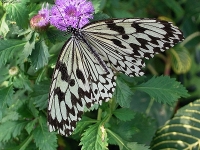
Coevolution and speciation
Plants and animals are constantly evolving in response to other species with whom they interact. This process known as coevolution is fundamental in ecology and evolution, but little is known about how it works and how it shapes species and ecological communities. NIMBioS postdoctoral fellow Tucker Gilman is developing a modeling framework to explore the relationship between coevolution and speciation.
Nov 22, 2010

The puzzle of biological diversity
Biologists have long thought that interactions between plants and
pollinating insects hasten evolutionary changes and promote biological
diversity. However, new findings show that some interactions between
plants and pollinators are less likely to increase diversity than
previously thought, and in some instances, reduce it.

The mathematics of biology
In an interview at the National Institute for Mathematical and Biological Synthesis, Assistant Professor of Mathematics at Maryville College Dr. Maria Siopsis explains why mathematics is a critical skill for biology students.
Click here to view the video.
(3 min 39 sec) Sep 10, 2010
Preserving nature on land and sea
At the National Institute for Mathematical and Biological Synthesis, four scientists have gathered from around the world to determine optimal strategies for designing and managing marine and terrestrial reserves.
Click here to view the video.
(6 min 23 sec) Sep 10, 2010
Relationship between a species' niche and its distribution
Dr. William Godsoe is a postdoctoral fellow at the National Institute for Mathematical and Biological Synthesis (NIMBioS). He uses probability theory to examine relationships between a species' niche and its geographic distribution. For more information about Dr. Godsoe's work, click here.
To view the video click here.
(3 min 51 sec) Aug 30, 2010
Cooperation and confict
Dr. Erol Akçay is a postdoctoral fellow at the National Institute for Mathematical and Biological Synthesis (NIMBioS). He investigates the dynamics of cooperation and conflict in animal social behavior and ecological mutualisms.
Click here to view the video.
(4 min 01 sec) Jun 29, 2010
Transmission dynamics of infectious disease
Dr. Folashade Agusto is a postdoctoral fellow at the National Institute for Mathematical and Biological Synthesis (NIMBioS).
She conducts research involving mathematical analysis and optimal control of transmission dynamics of infectious diseases,
focusing specifically on bovine tuberculosis, malaria and avian influenza.
Click here to view the video.
(1 min 53 sec) Jun 25, 2010
Jun 21, 2010

The evolution of biodiversity under a changing climate
The rate of climate change is happening so fast that many species cannot adapt quickly enough and risk extinction. Dr. Thibert-Plante studies the interaction between ecological and evolutionary forces and their impact in shaping the planet's biodiversity.

Biodiversity in a changing world
Dr. Xavier Thibert-Plante is a postdoctoral researcher at the National Institute for Mathematical and Biological Synthesis (NIMBioS). He studies the impact of climate change on biodiversity, specifically the evolution of biodiversity and the process of biodiversification in a changing environment.
Click here to view the video. (2 min 11 sec) Jun 14, 2010
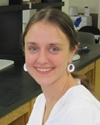
Ants and climate change
Dr. Sharon Bewick is a postdoctoral researcher at the National Institute for Mathematical and Biological Synthesis (NIMBioS). She studies how different ant species interact and how their interactions affect forest plant composition. She focuses particularly on how ant communities might be affected by disturbances in the global climate.
For more information about Dr. Bewick's research,
click here.
To view the video,
click here.
(2 min 23 sec) Jun 12, 2010
Jun 10, 2010
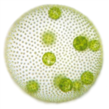
Model explains rapid transition
The transition from colonies of individual cells to multicellular organisms can be achieved relatively rapidly, within one million generations, according to a new mathematical model that simplifies our understanding of this process.

The evolution of the protein
Dr. Yi Mao is a postdoctoral researcher at the National Institute for Mathematical and Biological Synthesis. She studies enzymatic protein's role in biological energy production and the physical principles that drive protein evolution. Because the origins of many diseases lie in the malfunction of proteins, a better understanding of how proteins behave could lead to new discoveries in medicine.
Click here to view the video. (1 min 12 sec) May 24, 2010
May 13, 2010
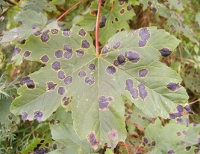
Emerging fungal disease
A new commentary on the nature of pathogens is raising startling new questions about the role that fundamental science research on evolution plays in the understanding of emerging disease.
Apr 14, 2010

Species distribution models
Separate species that live in radically different environments don't necessarily also have different ecological niches. This is the finding of a new study investigating the accuracy of current statistical tests that use models of geographic distributions to infer changes in environmental requirements.
Jan 20, 2010
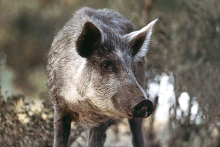
A mad itch
Feral swine have been described as the most worrisome of non-native species in the Great Smoky Mountains National Park. These free-roaming pigs not only root out native plants and destroy natural habitats, but can also carry disease, such as pseudo-rabies, which is often fatal if transmitted to other wild and domestic animals.
Jan 11, 2010
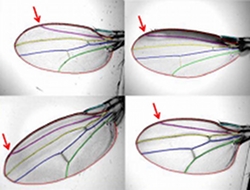
Darwinian morphometics and the problem of shape
Biologists have a rich array of quantitative tools for analyzing the genetics and evolution of traits, especially when the traits can be described by one or a few measurements. But describing some traits, such as gene expression profiles or life history patterns, is far more complex, often defined as a mathematical function of some other variable, such as body size as a function of age.
Dec 10, 2010
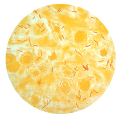
Mathematic models help formulate strategies for controlling infectious disease
Although largely eradicated in the United States, the scourge of bovine tuberculosis continues to devastate cattle herds and other animals in parts of the developing world. The disease is also still a threat to public health where it can be transmitted via contact with infected animals and by consuming unpasteurized milk. Folashade Agusto knows firsthand of the devastation in her home country of Nigeria, where few control measures are in place to help eradicate bovine tuberculosis (TB). A postdoctoral fellow at NIMBioS, Agusto's research focuses on developing mathematical models to analyze the transmission of bovine TB in cattle, wildlife and humans.
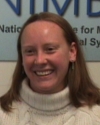
NIMBioS interview with Dr. Juliet Pulliam
In an interview at the National Institute for Mathematical and Biological Synthesis, Dr. Juliet Pulliam explains how mathematics is used to understand the transmission dynamics of infections transmitted from animals to people, like the monkeypox virus or Nipah virus. Click here to view the video. (NIMBioS video: 5 min 02 sec) Nov 18, 2010
Sep 24, 2010
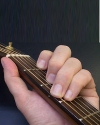
NIMBioS Songwriter-in-Residence
The National Institute for Mathematical and Biological Synthesis, in conjunction with the Univ. of Tennessee's James R. Cox Endowment Fund, is sponsoring a Songwriter-in-Residence Program to encourage the creation and production of songs involving ideas of modern biology and the lives of scientists who pursue research in biology.
Click here for more information.
Jul 1, 2010

Undergrads, vet students, teachers dive into summer research at NIMBioS
Sixteen students and two high school teachers from 16 different institutions across the United States lived on the university campus and worked in teams with professors on various research projects as a part of NIMBioS' Research Experiences for Undergraduates (REU) and Research Experiences for Veterinary Students (REV).
Click here to read more about it in Knoxville's hometown newspaper.

The fight of the feral cat
Kerrie Anne Loyd is a graduate student at the University of Georgia's Warnell School of Forestry and Natural Resources and a short-term visitor at the National Institute for Mathematical and Biological Synthesis (NIMBioS) on the campus of the University of Tennessee, Knoxville. She is developing a mathematical model to analyze and determine the most efficient way to manage feral cat populations. Click here to view the video. (NIMBioS video: 2 min 23 sec) May 18, 2010
Apr 27 2010
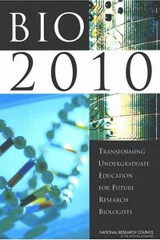
2010 NIMBioS/UBM award winners chosen
Nine undergraduate students from across the nation have been selected to receive a 2010 NIMBioS/UBM award to attend the Beyond BIO2010 Celebrations and Opportunities Symposium, May 21-22, in Washington, DC. The conference focuses on initiatives underway at the nation's colleges and universities to transform the way biology is taught at the undergraduate level. The award covers transportation to and from the conference, where students will present their research.
Apr 2010
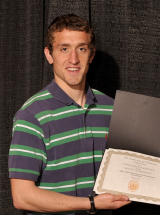
NIMBioS undergrad wins research award
Steve Fassino, who participated in the 2009 Research Experiences for Undergraduates
at NIMBioS, has won an undergraduate research award from the University of Tennessee, Knoxville (UT). Fassino, a junior majoring in mathematics at UT, won a EURēCA award in the College of Agricultural Sciences and Natural Resources division.
(Photo/Office of Research)
Apr 12, 2010
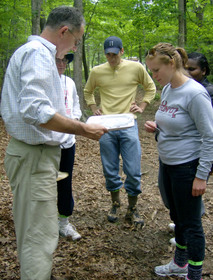
REU/REV students chosen
Seventeen students and two high school teachers from 17 different institutions across the United States have been chosen to participate in this year's summer research program at the National Institute for Mathematical and Biological Synthesis.
Apr 6, 2010
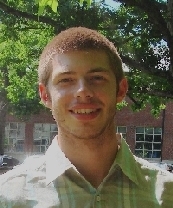
NIMBioS undergrad wins Goldwater Scholarship
Nathan Stebbins, a biochemistry and cellular and molecular biology major at the University of Tennessee, Knoxville, has been named a 2010 Barry M. Goldwater Scholar.
Stebbins is currently conducting research on cancer biology as an undergraduate.
Mar 2010
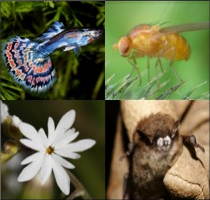
NIMBioS congratulates its newest postdocs
The National Institute for Mathematical and Biological Synthesis (NIMBioS) congratulates its newest postdoctoral fellows, who will begin their research at NIMBioS later this year:
R. Tucker Gilman,
Tom E. Ingersoll,
and
Xavier Thibert-Plante.
Feb 22, 2010

New guidebook helps life scientists navigate R statistical software
The National Institute for Mathematical and Biological Synthesis has released an introductory guide to data analysis using the R system to conduct statistical analysis and techniques widely used in the life sciences. Written by Marco Martinez, a graduate student in the department of mathematics at the University of Tennessee, Knoxville, R for Biologists was produced as companion material for the R Tutorial for Life Sciences seminar, held in 2009 and co-sponsored by NIMBioS and UT's Department of Ecology and Evolutionary Biology. Freely available on the Internet, R offers a variety of statistical and graphical techniques used by life science researchers.
Feb 16, 2010

AAAS symposium investigates math applications in biology
Under what conditions does an epidemic spread? What is the optimal way to design an effective HIV intervention plan? How does the human brain work when it makes poor choices? The answers to these questions can be found mathematically, and will be explored in a symposium at this year’s annual meeting of the American Association for the Advancement of Science, to be held Feb. 18-22 in San Diego.
Jan 6, 2010
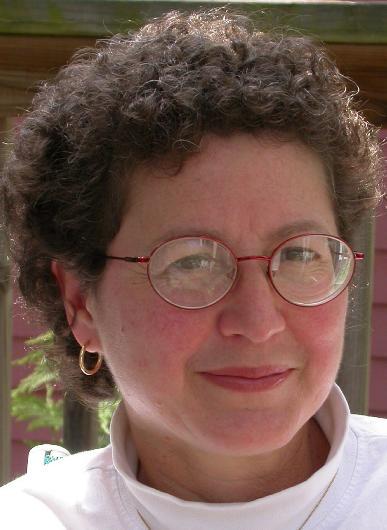
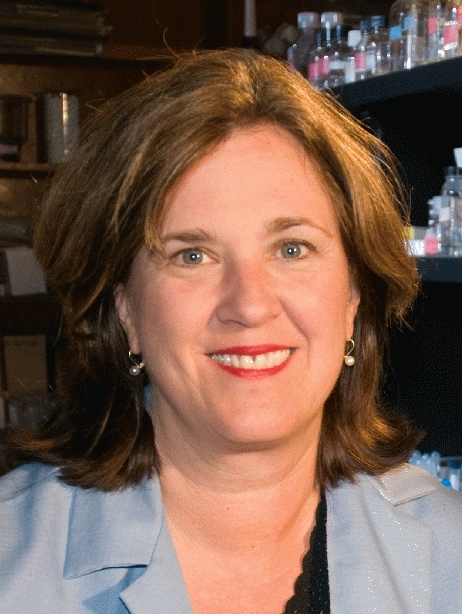
NIMBioS leaders among 11 UTK faculty named AAAS Fellows
NIMBioS leaders Suzanne Lenhart and Cynthia Peterson, were named 2010 fellows of the American Association for the Advancement of Science (AAAS). Lenhart is a professor of mathematics at UT and NIMBioS Associate Director for Education, Outreach and Diversity, while Peterson is a professor of biochemistry, cell and molecular biology and NIMBioS Associate Director for Graduate Education. AAAS named 11 UT Knoxville faculty members to the 2010 class of fellows, more new fellows than any other university in the South.
Dec 14, 2010
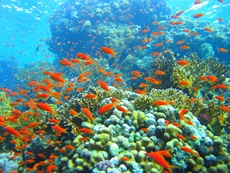
Congratulations to the newest NIMBioS recipients of support
The sustainability of coral reef ecosystems and nutrient cycling in food webs are among the topics to be studied in 2010 at NIMBioS. The range of topics to be investigated advance the Institute's mission to foster collaborative efforts to address biological questions using mathematical and computational methods.
Oct 28, 2009

Trees facilitate wildfires as a way to protect their habitat
Fire is often thought of as something that trees should be protected from, but a new study suggests that some trees may themselves contribute to the likelihood of wildfires in order to promote their own abundance at the expense of their competitors.
The study, which appears in the December 2009 issue of The American Naturalist, finds that positive feedback loops between fire and trees associated with savannas can make fires more likely in these ecosystems.
Oct 9, 2009

Songwriters, scientists put the pop in science at BioSongs Project
Todd Steed, R.B. Morris and other local singer-songwriters heard University of Tennessee, Knoxville scientists talk about their research at an all-day songwriting workshop on Wednesday, Oct. 14 at NIMBioS on the UT Knoxville campus. The NIMBioS BioSongs Project brought together singer-songwriters and UT biologists and mathematicians to share stories about research and about the people who do it, with the goal of sparking ideas for songs about modern biology.
Oct 14, 2009
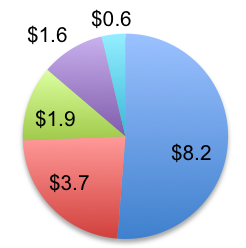
NIMBioS celebrates first year with more than 400 participants
NIMBioS celebrated its one-year anniversary in September, and thus far, more than 400 individuals from 15 countries and 43 states have participated in various research and educational activities.Located on the campus of the University of Tennessee, Knoxville, NIMBioS focuses on advancing research and education at the interface of biology and mathematics. Programs for visitors to NIMBioS began in March 2009, including working groups, investigative workshops, tutorials, and educational opportunities.
Oct 10, 2009
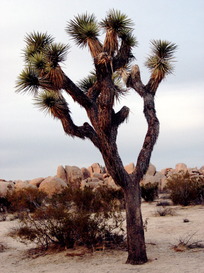
Scientist ties distribution modeling to ecological theory
As the planet warms, scientists have observed a radical disruption in the geographic distribution of thousands of animals and plants, which has unknown consequences for species survival.
William Godsoe, postdoctoral fellow at the NIMBioS, studies the statistical relationships between a species ecological requirements, or niche, and its distribution, which offers a way to predict and mitigate ecological challenges facing the plant, such as climate change, habitat loss and species invasion.
Sep 23, 2009
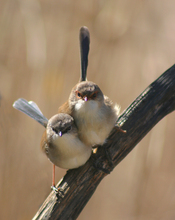
The evolution of social behavior: cooperation and conflict
In the course of a day, animals cooperate in a myriad different ways in order to increase their, and their species, chances of survival. In many species, for example, raising offspring requires help and cooperation from multiple individuals, and fending off predators can often be more effective when animals cooperate together as a herd.
Sep 16, 2009
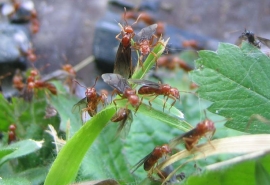
Ants and climate change
Dr. Sharon Bewick studies how ant communities might be affected by disturbances in the global climate as a part of her research as a postdoctoral fellow at NIMBioS. She also wants to know how temperature changes might affect the delicately balanced ecosystems in which ants live.
Sep 1, 2009
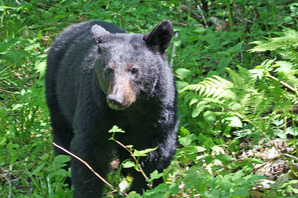
Modeling black bears
As a short-term visitor to NIMBioS, Dr. Rene Salinas' research focuses on developing computer models that simulate changes in the black bear population in eastern Tennessee and western North Carolina. The model could be used by wildlife managers to help determine the best strategy for minimizing bear-human conflict while maintaining a sustainable bear population.
Aug 26, 2009

Protein form and function
Proteins are the workhorses of biological processes. Because the origins of many diseases lie in the malfunction of proteins, a better understanding of how proteins behave could lead to new discoveries in medicine. At NIMBioS, postdoctoral fellow Yi Mao develops mathematical theories and algorithms to analyze bio-molecular systems, such as proteins.

Investigative workshop: Modeling bovine tuberculosis
U.S. authorities working to eradicate the spread of tuberculosis in cattle might benefit from predictive modeling approaches developed for European agricultural systems where more detailed animal movement data are available, according to summary findings from the first NIMBioS Investigative Workshop on Modeling Bovine Tuberculosis held July 7-9, 2009.

Working group: Ecology of niche variation
Consider the case of the three-spine stickleback. These tiny fish that thrive in oceans and in fresh water might appear to be the same, yet ecologists are finding that they are actually a diverse collection of highly specialized individuals. Understanding the causes and consequences of such ecological variation was the goal of a group of scientists who met at NIMBioS July 27-29, 2009.
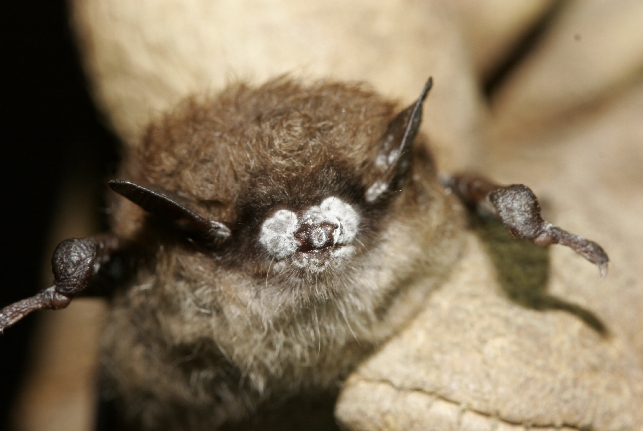
Investigative workshop: White nose syndrome in bats
A primary concern for wildlife managers tackling white-nose syndrome in bats is the ability to predict when and where in the United States the killer fungus will strike next, according to summary findings from the first NIMBioS Investigative Workshop on Modeling White Nose Syndrome (WNS) held June 30- July 2, 2009.
NIMBioS
1122 Volunteer Blvd., Suite 106
University of Tennessee
Knoxville,
TN 37996-3410
PH: (865) 974-9334
FAX: (865) 974-9461
Contact NIMBioS

